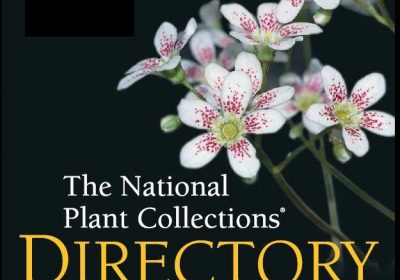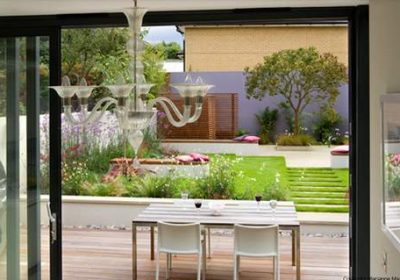INVESTING IN FUTURES – ENCOURAGING THE CONSERVATION OF CULTIVATED PLANTS
Description
Two interlinked nursery gardens in the NCCPG Plant Heritage Marquee, one from 1750 and one from 2006, demonstrate the difference that adventurers, explorers and plant hunters of the last 250 years have made to the range of plants available to gardeners today. The NCCPG’s ‘What if…?’ nursery gardens, designed by Edna Squires with assistance in plant sourcing and educational information from RHS Head of Botany John David, centre on the necessity of conserving the internationally diverse plant range now found in the UK: the NCCPG and RHS are jointly launching Britain’s first Action Plan for Conservation of Cultivated Plants today.
Preserving genetic diversity amongst cultivated plants has many benefits. “Veratrum nigrum from Shropshire’s National Plant Collection® Holder in Shropshire is being used by researchers working on childhood brain tumours, as the plant has been found to contain cyclopamine,” comments NCCPG Plant Heritage Vice Chairman David Goodchild, himself a National Plant Collection® Holder of Potentilla. “With wild habitats being destroyed and plants being bred as supermarket items, conserving our rich diversity of garden plants is vitally important.”
Whilst fashions may come and go, maintaining garden plant diversity offers both a window into history, and an opportunity to create better plants for the future. Scent, for example, is a characteristic discarded in plant breeding in the past in favour of other facets. It can often be reintroduced thanks to the retention of a wide range of species and cultivars. The retention, documenting and promotion of plant heritage is the central function of the NCCPG .
Highlighting the issues: examples from our exhibitors
The plant stories from many of the NCCPG’s National Plant Collections® illustrate some of the key issues facing cultivated plants and remind us of the necessity of maintaining a varied gene pool through conservation.
The plant stories from many of the NCCPG’s National Plant Collections® illustrate some of the key issues facing cultivated plants and remind us of the necessity of maintaining a varied gene pool through conservation.
The National Plant Collection® of Sarracenia is held by Paul Gardner of PJ Plants in Hereford. Some species of Sarracenia are now rare in their native habitats in wetter areas of the USA. New building, roads and highways are drying out the land and Sarracenia need a damp environment to survive. Having originally been introduced to the UK in Victorian times, many more Sarracenia were brought to this country by plantsman Adrian Slack in the 1970s, and his collection has since passed to Paul Gardener at PJ Plants, who continues this conservation work.
Laced old-fashioned pinks (Dianthus), being exhibited by Southview Nurseries, are an example of plants with a chequered conservation history. First bred in the late 1700s, they rapidly became popular with florists’ societies and very many new cultivars were developed, particularly by the Paisley Weavers. Yet by 1850, pollution in the Paisley area had caused such problems for the plants that few cultivars now remain. Remaining cultivars include Dianthus ‘Paisley Gem’ and Dianthus ‘Dad’s Favourite’.
One of the most striking conservation stories of recent years has been the devastation caused by the Canna virus, which now affects collections across the world. The virus had already destroyed one National Plant Collection® in the UK and a second, held by exhibitor Keith Hayward, is under threat. But NCCPG National Plant Collection® Holders are made of stern stuff and Mr Hayward has just built his own micropropagation unit in which he plans to attempt to bypass the Canna virus. He and his wife have bought a nursery in which the micropropagated plants will be bulked up and eventually made available to Canna enthusiasts.
Astrantia, being shown by Warren Hills Nurseries, first arrived in Britain in 1752 with Astrantia major from wet gulleys in Spain and Italy. Although well-known to the Victorians, Astrantia breeding began flourishing in the 1970s with the introduction of new species. Astrantia are now so popular that nomenclature problems are occurring, as cultivars are being re-named in European trade marketing.
Fibrex Nurseries are exhibiting some of the Pelargonium species which form the building blocks of today’s popular plants, including Pelargonium zonale and Pelargonium inqinan. Pelargonium species were first introduced to the UK from South Africa in 1620. By 1750, the period of our first nursery display garden, Pelargonium graveolens and Pelargonium ‘Attar of Roses’ were already well known in the UK. Fibrex hope the Marquee’s displays will inspire visitors with a desire to create new cultivars for the future.
Streptocarpus, being exhibited by Dibleys Nursery, were also introduced from south Africa and Madagascar, from the 1820 onwards, though many have now been lost to cultivation. Dibleys’ National Plant Collection® of Streptocarpus contains plants from 1930 onwards: the nursery has introduced 40 new varieties itself in the last 25 years.
Plant collecting and breeding has been a major feature of the last 150 years, with the diversity of plants arriving in the UK increasing with international trade and exploration. Buxus, being exhibited by Langley Boxwood Nursery, was used by Roman invaders of the UK, though it was the activities of Victorian collectors travelling in China, Korea and Japan in particular that helped to expand the range available today. Penstemon too, though first introduced to the UK in the mid 18th century, benefited from collecting and development activities in the 19th century, especially through the work of John Forbes Hoick. Many of the cultivars available today however are from breeding work between 1900 and 1925. Penstemon are being exhibited by National Plant Collection® Holder Mrs Shirley Reynolds .
New National Plant Collection® Holder for alpine Campanula, Sue Wooster, brings the plant conservation story up to date with some of the alpine Campanula bred by plantsman Alan Bloom, for whom these plants were an abiding passion, alongside a number of less available cultivars. Many alpine Campanula cultivars have been lost to cultivation in the last 20 years, with the number listed in the RHS Plantfinder now diminishing rapidly.
Other National Plant Collection® Holders in the NCCPG Plant Heritage Marquee this year include:
Agapanthus: Mr & Mrs R J Fulcher
Cacti: Mr Brian Fean of Abbey Brook Cactus Nursery
Delphinium: Rougham Hall Nurseries
Fuchsia: Mr G Puddlefoot
Pelargonium (Angel): Mr Derek L Dean
Rubus sp: Mr B Clarke
Sisyrinchium and Tigridieae tribe: Mr & Mrs E Heaton
Tricyrtis: Mr R Bramley of Farmyard Nurseries.
Agapanthus: Mr & Mrs R J Fulcher
Cacti: Mr Brian Fean of Abbey Brook Cactus Nursery
Delphinium: Rougham Hall Nurseries
Fuchsia: Mr G Puddlefoot
Pelargonium (Angel): Mr Derek L Dean
Rubus sp: Mr B Clarke
Sisyrinchium and Tigridieae tribe: Mr & Mrs E Heaton
Tricyrtis: Mr R Bramley of Farmyard Nurseries.



